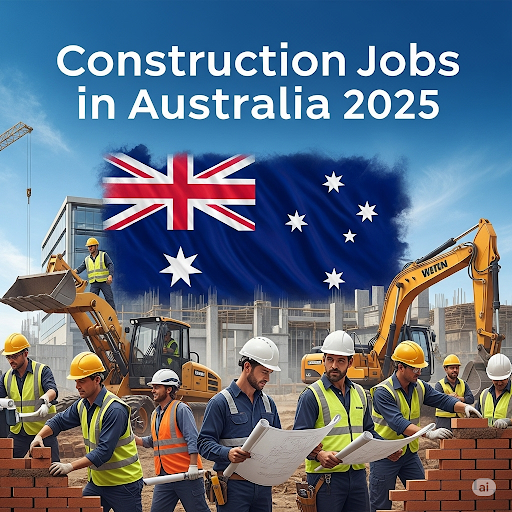Australia’s construction industry, a cornerstone of its AUD 2.7 trillion economy, is projected to contribute AUD 150 billion in 2025, yet faces a critical shortage of 100,000 workers.
This labor gap creates a wealth of visa-free construction jobs paying AUD 50,000-$100,000 annually for citizens of visa-exempt countries, such as New Zealand, and Working Holiday Visa (WHV) holders from over 40 nations.
Roles like laborers, carpenters, bricklayers, and concreters are in high demand, offering immediate work opportunities without the need for employer sponsorship.
This comprehensive guide explores job prospects, eligibility criteria, application strategies, and pathways to success in Australia’s booming construction sector for 2025.
Construction roles, classified under ANZSCO 8211-8219, encompass a range of tasks from site preparation and material handling to skilled trade work in residential, commercial, and infrastructure projects.
Platforms like Jora list 2,500+ construction jobs, with hourly rates ranging from AUD 25-$50. Recent postings highlight opportunities with major firms like Lendlease, Multiplex, and Downer Group in cities such as Sydney, Melbourne, and Brisbane.
In 2023-24, Australia issued 155,193 temporary visas, welcoming talent from New Zealand, the UK, Canada, Ireland, and other WHV-eligible countries.
Visa-free workers, leveraging agreements like the Trans-Tasman Travel Arrangement or WHV (subclasses 417/462), can start work immediately, bypassing the complexities of sponsored visas.
Whether you’re a New Zealander with unrestricted work rights or a backpacker on a WHV, now is the time to tap into Australia’s construction boom and secure a high-paying job.
Why Choose Construction Jobs in Australia?
Australia’s construction sector offers compelling benefits for visa-free workers, combining competitive salaries with a high quality of life. Jobs pay AUD 50,000-$100,000 annually, with skilled trades like electricians and site supervisors earning up to AUD 120,000.
Benefits include overtime pay (time-and-a-half or double-time), superannuation contributions (11.5% of wages), and employer-provided safety training, making these roles financially rewarding.
The industry’s 5% annual growth, driven by infrastructure projects like the Melbourne Metro Tunnel and Sydney’s WestConnex, ensures job stability.
Visa-free access through WHV (417/462) or New Zealand citizenship allows workers to begin immediately, with WHV holders able to extend their stay by completing 88 days of regional work, including construction in eligible areas.
Employers like Fulton Hogan and Metricon offer on-the-job training, career progression, and pathways to trade certifications.
Beyond financial rewards, workers enjoy Australia’s vibrant cities and regional towns. Sydney’s bustling urban scene, Melbourne’s cultural richness, and Brisbane’s subtropical climate provide diverse lifestyles.
Regional areas like Cairns or Kalgoorlie offer lower living costs (AUD 1,200/month) and quieter communities. Networking through organizations like Master Builders Australia or the Housing Industry Association (HIA) supports long-term career development.
These advantages position Australia as a prime destination for construction professionals seeking visa-free opportunities.
Overview of Visa-Free Construction Jobs
Construction jobs in Australia span unskilled and skilled roles, catering to a wide range of experience levels. Laborers (ANZSCO 8211) perform foundational tasks like site clearing, concrete mixing, and material transport, requiring minimal experience.
Skilled trades, such as carpenters (ANZSCO 3312), bricklayers (ANZSCO 3311), concreters (ANZSCO 8215), and scaffolders (ANZSCO 8217), involve structural work, formwork, or safety rigging.
Site supervisors (ANZSCO 3121) oversee projects, requiring 5+ years’ experience. Companies like Brookfield, John Holland, and CPB Contractors hire for projects nationwide.
Salaries range from AUD 25-$50/hour, translating to AUD 50,000-$100,000/year for full-time work (38 hours/week). Overtime, common on tight deadlines, boosts earnings by 20-30%.
Full-time roles dominate (80%), with casual (15%) and part-time (5%) positions growing, especially for WHV holders seeking flexibility.
For example, a laborer role in Sydney with Downer Group pays AUD 30/hour, while a carpenter in Brisbane with Metricon earns AUD 40/hour, both accessible to WHV workers.
- Key job details:
- Roles: Laborer, carpenter, bricklayer, concreter, scaffolder, site supervisor, electrician, plumber.
- Sectors: Residential housing, commercial buildings, infrastructure, civil engineering.
- Salary: AUD 25-$50/hour, AUD 50,000-$100,000/year; overtime bonuses.
- Hours: Full-time (80%), casual (15%), part-time (5%), 38-50 hours/week.
- Visa: WHV (417/462), New Zealand citizenship, no sponsorship required.
- Demand: 2,500+ jobs on Jora, 2,000+ on Seek, 100,000 worker shortage (2025).
The market is robust, with 7% growth fueled by government-backed projects. Regional roles in Queensland and Western Australia qualify for WHV extensions, enhancing visa flexibility. A White Card (AUD 60-$80), mandatory for site access, and physical fitness are key requirements.
Eligibility for Visa-Free Construction Jobs
Eligibility for visa-free construction jobs is straightforward but varies by role and visa status. Laborers require a high school diploma or equivalent and 0-2 years’ experience, while skilled trades like carpentry or bricklaying need 2-5 years’ experience or a trade certificate (e.g., Certificate III in Carpentry, AUD 1,000-$2,000).
Conversational English (IELTS 5.0 equivalent) is essential for safety communication, though formal testing is rarely required. A White Card, obtained through a 6-hour safety course (AUD 60-$80), is mandatory for all site work.
Visa-free access is available to:
- New Zealand citizens under the Trans-Tasman Travel Arrangement, granting unlimited work rights with a valid passport.
- WHV holders (subclasses 417/462), aged 18-30 (or 35 for Canadians, Irish, and others), from countries like the UK, Canada, Ireland, Germany, and Japan. WHV costs AUD 510 and allows 12 months’ work, with a 6-month limit per employer, extendable by 1-2 years with 88 days of specified regional work, including construction in postcodes like 4700 (Queensland).
Applicants must pass health and character checks for WHV, including police clearances ($50) and medical exams ($200). Informal experience, such as home renovations or community projects, can qualify if documented via references.
- Eligibility requirements:
- Education: High school diploma; trade certificates (AUD 1,000-$2,000) for skilled roles.
- Experience: 0-2 years (laborers), 2-5 years (skilled trades), 5+ years (supervisors).
- Language: Conversational English (IELTS 5.0 equivalent) for safety.
- Skills: Manual labor, tool operation, safety compliance, trade-specific expertise.
- Visa: WHV (417/462, AUD 510), New Zealand citizenship, valid passport.
- Certifications: White Card (AUD 60-$80), First Aid ($150, optional), trade licenses ($200-$500).
Early completion of the White Card course via providers like Urban E-Learning ensures job readiness. Health and stamina are critical, as roles involve lifting, bending, and outdoor work in Australia’s variable climate.
Steps to Secure Visa-Free Construction Jobs
Securing a construction job requires building relevant skills, researching employers, applying strategically, and ensuring visa compliance. Job boards like Jora (2,500+ jobs), Seek (2,000+ roles), and Backpacker Job Board cater to visa-free workers, listing opportunities with firms like Fulton Hogan and CPB Contractors.
Applications need an Australian-style resume (2 pages, no photo), cover letter, and proof of White Card. Interviews focus on physical ability, safety awareness, and trade skills.
For WHV applicants, apply via the Department of Home Affairs ($510, 1-2 months processing), providing health and character documents.
New Zealand citizens can start work immediately with a passport. Obtain a White Card (AUD 60-$80) before applying, as it’s a prerequisite. Begin job searches by March 2025 for mid-2025 roles to align with peak hiring.
- Steps to secure jobs:
- Build Skills: Gain 0-2 years’ experience; complete White Card or First Aid training.
- Research: Use Jora, Seek, Backpacker Job Board, or agencies like Sharp Labour Hire.
- Apply: Submit resume, cover letter, White Card, and trade references.
- Interview: Demonstrate stamina, safety knowledge, and tool proficiency.
- Visa: Apply for WHV via Home Affairs (non-New Zealanders); verify regional postcodes.
- Relocate: Arrange housing, comply with state safety laws (e.g., SafeWork NSW).
Tailor resumes to highlight skills like scaffolding or formwork. For example, a bricklayer role in Melbourne with Brookfield pays AUD 45/hour. Contact SafeWork Australia for compliance guidance.
Visa-Free Work Arrangements
Visa-free work is facilitated by two primary pathways:
- Working Holiday Visa (417/462): Costs AUD 510, allows 12 months’ work for 18-30/35-year-olds from 40+ countries, with a 6-month limit per employer. Extensions require 88 days of specified regional work, such as construction in postcodes like 4825 (Mount Isa, Queensland). Apply online via Home Affairs, submitting health and police checks.
- New Zealand Citizenship: Grants unlimited work rights under the Trans-Tasman Travel Arrangement, requiring only a valid passport. No processing time or fees apply.
WHV holders must work in regional areas for extensions, with construction roles in agriculture, mining, or infrastructure qualifying. No employer sponsorship is needed, unlike TSS (482) visas, saving time and costs (LMT $1,200, visa $1,290-$3,035).
- Visa-free essentials:
- WHV (417/462): AUD 510, 1-3 years, 18-30/35, 6-month employer limit.
- New Zealand Citizenship: Unlimited work rights, passport only.
- Documents: Passport, health certificate ($200), police clearance ($50).
- Processing: 1-2 months (WHV), instant (New Zealanders).
- Extensions: 88 days’ regional work (WHV), not applicable for New Zealanders.
- Costs: WHV ($510), health checks ($200), police checks ($50).
For example, a WHV laborer in Townsville can extend their visa with regional construction work. Check eligible postcodes via Home Affairs to plan extensions. Early applications prevent delays.
Benefits of Visa-Free Construction Jobs
Construction jobs offer competitive salaries (AUD 50,000-$100,000), with skilled trades like plumbers earning up to AUD 120,000.
Employers contribute 11.5% superannuation, provide safety gear, and offer free White Card training. Visa-free access ensures immediate starts, bypassing sponsorship delays.
High demand, with 2,500+ roles on Jora and a 100,000-worker shortage, guarantees stability. Laborers require minimal experience, while skilled roles lead to promotions. Workers access Master Builders Australia events for networking and certifications like Certificate III in Construction (CPC30220, AUD 1,500).
- Job benefits:
- Financial: AUD 25-$50/hour, AUD 50,000-$100,000/year, overtime bonuses.
- Security: 2,500+ jobs on Jora, 2,000+ on Seek.
- Support: Superannuation (11.5%), safety gear, training programs.
- Flexibility: Full-time (80%), casual (15%), part-time (5%).
- Immigration: WHV extensions via regional work, no sponsorship delays.
- Growth: Trade certifications (AUD 1,500), promotions to site supervisor.
For example, a scaffolder role in Perth with John Holland pays AUD 42/hour with superannuation. The sector’s accessibility suits visa-free workers. Regional jobs support WHV renewals and career longevity.
Where to Find Visa-Free Construction Jobs
Finding jobs involves leveraging job boards, employer websites, and industry networks. Jora lists 2,500+ roles, Seek offers 2,000+ jobs, and Backpacker Job Board curates WHV-eligible listings.
Major employers like Lendlease, Multiplex, Fulton Hogan, and Downer Group post openings for laborers and tradespeople. Following X accounts like @AusJobsNow or @ConstructionAus provides real-time job alerts.
Networking with Master Builders Australia or attending job fairs in Sydney and Brisbane connects you with hiring managers. Forums like Reddit’s r/AustraliaJobs offer insights from workers like Sarah, a Canadian carpenter who earned AUD 70,000 in Cairns. Agencies like Sharp Labour Hire and Chapex Labour provide job-matching for WHV holders.
- Resources for job search:
- Job Boards: Jora (2,500+ roles), Seek (2,000+), Backpacker Job Board.
- Employer Sites: Lendlease, Multiplex, Fulton Hogan, Downer Group.
- Social Media: @AusJobsNow, @ConstructionAus for updates.
- Networks: Master Builders Australia, HIA, job fairs in Melbourne.
- Forums: Reddit’s r/AustraliaJobs, Gumtree for peer advice.
- Agencies: Sharp Labour Hire, Chapex Labour, WorkPac for job-matching.
Verify job legitimacy via official sites to avoid scams, especially on platforms like Gumtree. Start searching by March 2025 for mid-2025 roles. Direct employer contact accelerates hiring.
Application Tips for Success
A strong application showcases physical stamina, certifications, and reliability. Australian resumes (2 pages, no photo) should list White Card, trade experience, and specific projects (e.g., “Assisted formwork for 10-story residential building”). Cover letters must address employer needs, emphasizing safety compliance, tool proficiency, or trade skills like bricklaying.
Prepare for interviews by practicing trade tasks (e.g., measuring cuts for carpentry) and answering safety questions (e.g., “How do you handle heat stress?”). Secure a White Card (AUD 60-$80) via providers like Urban E-Learning before applying. Follow up with employers within 1-2 weeks to demonstrate commitment.
- Application best practices:
- Resume: 2 pages, list White Card, trade skills, and project history.
- Cover Letter: Highlight safety, stamina, and role-specific expertise.
- Certifications: White Card ($60-$80), First Aid ($150), trade licenses ($200-$500).
- Interview: Demonstrate tool use, safety knowledge, and teamwork.
- Timeline: Start March 2025, apply by June for mid-2025 roles.
- Follow-Up: Email employers within 1-2 weeks post-application.
For example, a concreter role in Adelaide with CPB Contractors pays AUD 38/hour. Optimize LinkedIn for recruiter visibility, including White Card details. Early applications enhance competitiveness in a market with 2,500+ applicants.
Cost of Relocating and Working in Australia
Relocating to Australia costs AUD 3,000-$10,000, covering flights ($500-$2,000), housing deposits ($1,000-$3,000), and White Card ($60-$80). WHV applicants pay visa fees ($510), health checks ($200), and police clearances ($50). Living costs range from AUD 1,500-$3,500/month, with regional areas like Townsville (AUD 1,200/month) being more affordable than Sydney (AUD 2,500/month).
Salaries (AUD 50,000-$100,000) and overtime (20-30% extra) cover expenses. Additional costs include taxes (15-37%, depending on income) and personal expenses ($400/month). Budgeting for transport ($120/month) and superannuation withdrawals (for WHV holders upon departure) ensures financial stability.
- Key expenses:
- Visa: WHV ($510), health checks ($200), police checks ($50).
- Relocation: Flights ($500-$2,000), housing ($1,000-$3,000).
- Living: AUD 1,500-$3,500/month (housing, food, transport).
- Certifications: White Card ($60-$80), First Aid ($150, optional).
- Taxes: 15-37% on income, consult tax professional.
- Extras: Transport ($120/month), personal expenses ($400/month).
Overtime and regional roles with accommodation (e.g., Kalgoorlie mining camps) reduce costs. Confirm benefits like transport allowances with employers. Budgeting maximizes savings and remittances ($5,000/year).
Networking for Job Success
Networking with employers, trade associations, and labor hire agencies boosts job prospects. Attend Master Builders Australia job fairs in Brisbane or webinars by Chapex Labour. Connect with recruiters on LinkedIn or follow @ConstructionAus for job leads and industry updates.
Join online communities like Reddit’s r/AustraliaJobs or HIA forums to share tips and learn from peers. Follow up with contacts within 1-2 weeks to maintain relationships. For example, a New Zealand laborer secured a Sydney role with Lendlease after attending a job fair, earning AUD 65,000 annually.
- Networking strategies:
- Attend: Job fairs in Sydney, Chapex Labour webinars, HIA events.
- Connect: LinkedIn recruiters, @ConstructionAus, @AusJobsNow.
- Engage: Reddit’s r/AustraliaJobs, HIA forums, Backpacker Job Board groups.
- Contact: Email firms (e.g., [email protected]).
- Follow-Up: Message contacts within 1-2 weeks post-interaction.
- Join: Master Builders Australia, local trade groups post-relocation.
Start networking by March 2025 to build connections before peak hiring. Feedback from industry groups refines resumes and interview skills. Persistent engagement secures high-paying roles.
Challenges for Applicants
The construction job market is competitive, with 2,500+ applicants vying for roles. WHV processing delays (1-2 months) and regional work requirements (88 days for extensions) can complicate plans. Obtaining a White Card ($60-$80) and health checks ($200) demands time and investment.
Language barriers, requiring conversational English (IELTS 5.0 equivalent), may challenge non-native speakers, particularly for safety-critical tasks. Documenting informal experience (e.g., volunteer construction) can be difficult without references. Job scams targeting WHV holders, often on unofficial platforms like Gumtree, are prevalent. Physically demanding roles, involving 8-10 hour shifts in heat or rain, require stamina and resilience.
- Common challenges:
- Competition: 2,500+ applicants for construction roles.
- Visa Delays: WHV processing (1-2 months).
- Costs: White Card ($60-$80), health checks ($200), police checks ($50).
- Language: Conversational English, preparation needed for safety.
- Scams: Verify jobs via Jora or Seek, avoid unofficial platforms.
- Demands: Physical stamina, safety compliance, variable weather conditions.
Mitigate risks by using reputable job boards like Seek, preparing for interviews with safety scenarios, and verifying regional postcodes via Home Affairs. Apply to multiple employers by June 2025 to increase chances. Resilience and preparation overcome obstacles.
Tips for Long-Term Success
Sustaining a construction career in Australia requires ongoing skill development, networking, and adaptability. Enroll in trade courses like Certificate III in Carpentry (CPC30220, AUD 1,500) or White Card refreshers ($50) to enhance qualifications. Attend HIA or Master Builders Australia events to build industry connections and explore job opportunities.
Aim for promotions to site supervisor or foreman roles, which pay AUD 80,000-$120,000, after 2-4 years of experience. Maintain strict safety compliance, as violations can jeopardize WHV extensions or future visa applications. Build strong relationships with employers to secure references for permanent residency pathways like the Employer Nomination Scheme (ENS 186) after WHV.
For WHV holders, complete 88 days of regional work in construction to qualify for visa extensions, prioritizing high-demand areas like Cairns or Kalgoorlie. Save earnings to cover living costs, remittances ($5,000/year), and superannuation claims upon departure.
- Success strategies:
- Upskill: Complete CPC30220 ($1,500), First Aid ($150), or trade licenses.
- Network: Attend HIA events, connect with local professionals.
- Perform: Demonstrate stamina, safety compliance, and reliability.
- Advance: Target site supervisor roles after 2-4 years.
- Renew: Complete 88 days’ regional work for WHV extensions.
- Save: Budget earnings for costs, remittances, and superannuation claims.
For example, an Irish carpenter advanced to a supervisor role with Fulton Hogan after earning CPC40120, boosting earnings to AUD 90,000. Document projects and safety training for visa or job applications. Consistent effort ensures career longevity.
Regional Opportunities for Construction Jobs
Sydney, Melbourne, and Brisbane account for 60% of construction jobs, driven by urban projects like Barangaroo and Queen’s Wharf. Regional areas like Cairns, Townsville, and Kalgoorlie offer WHV extension-eligible roles, with laborers earning AUD 28-$35/hour and carpenters AUD 40-$50/hour. Rural employers, such as those in Western Australia’s mining sector, often provide accommodation, reducing living costs to AUD 1,200/month compared to Sydney’s AUD 2,500/month.
Regional shortages, with 25% of roles unfilled in Queensland and Western Australia, create high demand. White Card requirements are universal, but rural employers may offer on-site training. Networking with local chambers of commerce or regional job boards like Queensland Country Life enhances prospects.
- Regional job insights:
- Locations: Sydney, Melbourne, Brisbane, Cairns, Townsville, Kalgoorlie.
- Roles: Laborer, carpenter, bricklayer, concreter, scaffolder, electrician.
- Salary: AUD 25-$50/hour, AUD 50,000-$100,000/year, overtime bonuses.
- Visa: WHV (417/462), New Zealand citizenship.
- Demand: 25% of roles unfilled in Queensland, high regional demand.
- Benefits: Accommodation in rural areas, lower living costs in Townsville.
For example, a laborer role in Kalgoorlie with Downer Group offers AUD 32/hour plus accommodation. Contact regional job boards or agencies like WorkPac for leads. Rural roles suit WHV holders seeking visa extensions and cost savings.
Cultural Adaptation for Construction Workers
Adapting to Australia’s workplace culture is critical for job success. Employers prioritize punctuality, safety compliance, and teamwork, with strict adherence to Work Health and Safety (WHS) regulations. Construction sites foster a “mate” culture, valuing camaraderie and mutual support, but expect workers to follow protocols rigorously.
Join safety workshops ($50-$100) through providers like SafeWork Australia to master WHS standards, covering topics like heat stress and fall prevention. Engage with diverse crews, as 20% of construction workers are immigrants, bringing varied perspectives. Learning Australian slang (e.g., “smoko” for break, “arvo” for afternoon) and understanding holidays like Australia Day builds rapport with colleagues.
- Adaptation strategies:
- Learn: Study WHS regulations via workshops or online courses.
- Engage: Collaborate with diverse crews, respect “mate” culture.
- Communicate: Use clear, polite language; learn Aussie slang.
- Participate: Attend community events like BBQs to build networks.
- Integrate: Join immigrant support groups for relocation tips.
- Support: Access settlement services via Home Affairs for guidance.
For example, a Canadian laborer thrived at Multiplex by embracing WHS protocols and team banter, earning respect and a promotion. Cultural fluency enhances job applications and workplace integration. Adaptability ensures long-term success.
Financial Planning for Relocation
Salaries (AUD 50,000-$100,000) and overtime (20-30%) cover relocation costs (AUD 3,000-$10,000) and annual living expenses (AUD 18,000-$42,000). WHV holders often send remittances ($5,000/year) to support families abroad. Budgeting ensures savings, including superannuation claims (11.5% of wages, claimable upon departure).
Consult financial advisors ($100-$200) to plan taxes (15-37%, with 15% for WHV holders on incomes up to AUD 45,000) and remittances. Research regional costs, as housing in Townsville ($1,200/month) is far cheaper than Melbourne ($2,200/month). Maintain a reserve of AUD 5,000-$10,000 for emergencies or return travel.
- Financial planning tips:
- Budget: Allocate salaries for flights ($500-$2,000) and housing ($1,000-$3,000).
- Save: Reserve AUD 5,000-$10,000 for emergencies and return travel.
- Remit: Plan $5,000/year for family support abroad.
- Taxes: Budget 15-37% for taxes, file via Australian Taxation Office.
- Research: Compare housing costs in regions (e.g., Townsville vs. Sydney).
- Consult: Use advisors for tax, superannuation, and remittance planning.
Overtime, superannuation, and regional perks like accommodation ease financial strain. Confirm benefits with employers, such as transport allowances or site meals. Prudent planning maximizes earnings and supports long-term goals.
Health and Safety in Construction
Australia’s construction industry prioritizes safety, with SafeWork Australia enforcing WHS laws. Workers must complete White Card training (AUD 60-$80) to understand risks like falls, heat exhaustion, and equipment hazards. Employers provide personal protective equipment (PPE), including hard hats, boots, and hi-vis vests, often at no cost.
Regular site inspections and toolbox talks reinforce safety protocols. Workers must report incidents immediately and follow site-specific rules, such as hydration schedules in summer (temperatures can exceed 35°C). First Aid training ($150) enhances employability and preparedness.
- Safety strategies:
- Train: Complete White Card ($60-$80) and First Aid ($150).
- Comply: Follow WHS rules, wear PPE, attend toolbox talks.
- Monitor: Stay hydrated, watch for heat stress or fatigue.
- Report: Notify supervisors of hazards or incidents promptly.
- Prepare: Learn site-specific safety plans during induction.
- Update: Refresh White Card knowledge annually ($50).
For example, a UK scaffolder avoided injury at Lendlease by adhering to fall prevention protocols. Safety compliance boosts job security and visa eligibility. Proactive health management ensures career longevity.
Conclusion
Visa-free construction jobs in Australia for 2025 offer salaries of AUD 50,000-$100,000, immediate work rights, and career stability in a booming industry. By securing a White Card, leveraging job boards like Jora, and targeting regional roles for WHV extensions, you can build a rewarding career. Start now to seize these opportunities and thrive in Australia’s construction sector.
Visit seek.com.au, follow @ConstructionAus, and contact SafeWork Australia for guidance. With preparation and resilience, you’ll succeed in this high-demand market. Share your journey in the comments or reach out for tips!






